Tianmen Mountain National Forest Park is located 8 kilometers south of the urban area of Zhangjiajie City, Hunan Province, and is a mountain-type natural scenic area. It is a World Geopark, a National Forest Park, and a National 5A-level tourist attraction. The total area of the park is 96 square kilometers, with the top area reaching 2 square kilometers and the main peak at an altitude of 1,518.6 meters. Its primary secondary forest coverage rate is 90%, with rich germplasm resources. Tianmen Mountain gets its name from the natural wonder Tianmen Cave. The mountain ranges from 1,350 to 1,500 meters above sea level and is a complete synclinal structural unit geologically, developing a typical mid-mountain karst platform peak forest canyon landform. The upper part of the mountain features karst platform cliff landscapes, while the lower part has karst peak forest canyon landscapes. The entire mountain is dotted with karst hills, stone buds, depressions, funnels, and caves. It differs from the sandstone peak forest landscape of Wulingyuan by its relatively complete karst landform, making it an isolated platform-shaped mountain. It has a subtropical mountain-type monsoon humid climate, with daily temperatures about 6-8 degrees Celsius lower than the urban area and 12-14 hours of sunshine. Due to differences in altitude and temperature, the four seasons on Tianmen Mountain have evolved into two distinct seasons.
Historical Culture
Tianmen Mountain was originally called Songliang Mountain. During the Three Kingdoms Period, the cliff of Songliang Mountain suddenly opened up like a door, forming the rare world wonder - Tianmen Cave. Emperor Sun Xiu of the Wu Kingdom regarded this as an auspicious omen, so he renamed Songliang Mountain "Tianmen Mountain" and established Tianmen County at the foot of the mountain, which is today's Zhangjiajie City.
According to records, from the 18th year of Qianlong in the Qing Dynasty (1753) to the 5th year of the Republic of China (1916), Tianmen Mountain underwent 7 renovations over 163 years. It was the Buddhist center of western Hunan and the highest-altitude Buddhist building complex in Hunan Province. In 2002, Tianmen Mountain Temple was rebuilt and opened to the public on June 9, 2009.
For thousands of years, six unsolved mysteries - "Tianmen Cave Opening", "Tianmen Water Overflow", "Tianmen Direction Shifting", "Yefu Hiding Treasures", "Guigu Appearing in Shadow", and "Tianmen Auspicious Beast" - have emerged one after another, adding more mysterious charm to this place.
Major Scenic Spots
Tianmen Cave
Tianmen Cave is the world's highest-altitude natural through-mountain cave, located in the middle-upper part of Tianmen Mountain at an altitude of 1,300 meters. It runs through the mountain from north to south, with a height of 131.5 meters, a width of 57 meters, and a depth of 60 meters. Standing tall and straight, it looks like a gateway connecting the sky. On clear days, the "Tianmen Mist Spitting" scene can be seen; in winter, it is surrounded by clouds and mist like "Tianmen Mist Spitting"; in summer, waterfalls pour down like "Plum Blossom Rain". Historical records also mention natural wonders such as "Tianmen Divine Light", and local chronicles record that Tianmen Cave has "Ten Scenic Views of Tianmen". The "Heavenly Staircase" leading to Tianmen Cave has a total of 999 steps, which is not only a path to Tianmen Cave but also a sacred place for making wishes and praying.
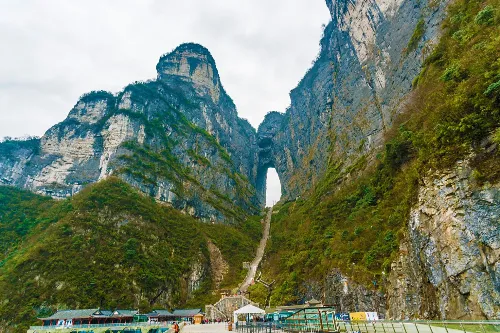
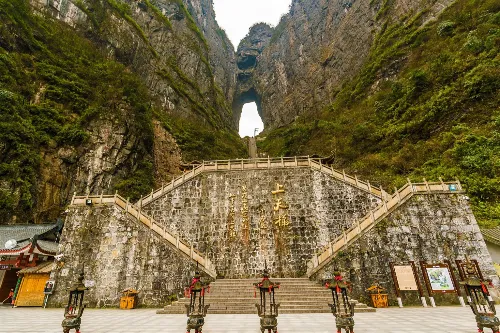
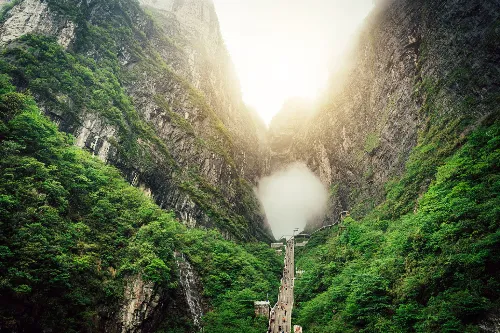
Tongtian Avenue
Tongtian Avenue gets its name from leading to Tianmen Cave. It is 10.77 kilometers long and winds with 99 bends. Every 9 bends, there is a stone tablet as a marker, implying "Nine Heavens". Its altitude rises sharply from 200 meters to 1,300 meters, and it is known as "the most spectacular highway in the world". The construction of this highway started in 1998. Due to the unique geological and climatic conditions of Tianmen Mountain, the construction process was very difficult, and it was not fully connected until 2005.
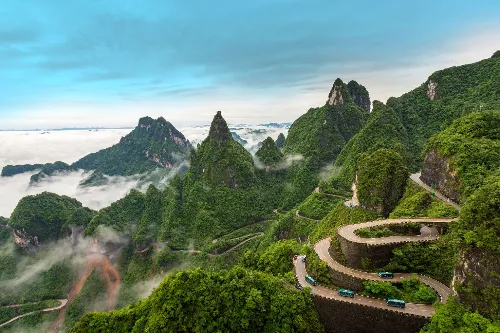

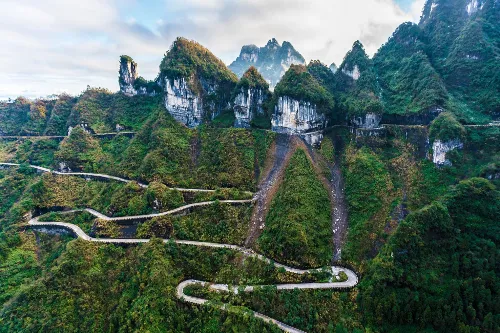
Glass Plank Road
The Glass Plank Road in the Mixian Qijing Scenic Area is 1,600 meters long, with an average altitude of 1,400 meters. The entire plank road stands in the middle of a cliff thousands of feet high, allowing tourists to experience the excitement of walking in the air. Currently, glass plank roads about 60 meters long have also been built in the West Line, East Line, and Panlong Cliff. Among them, the West Line is more thrilling, while the East Line has fewer tourists. Tourists need to rent shoe covers to walk on the glass plank road.
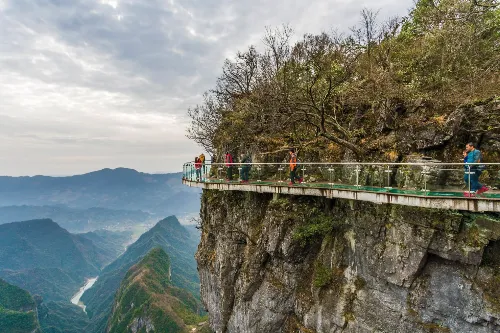
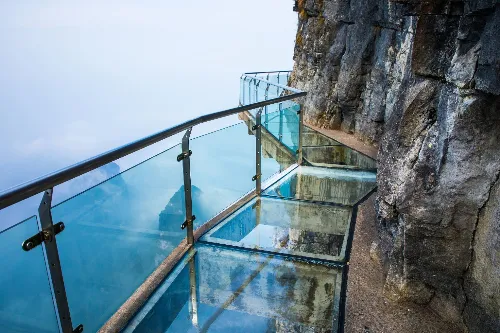
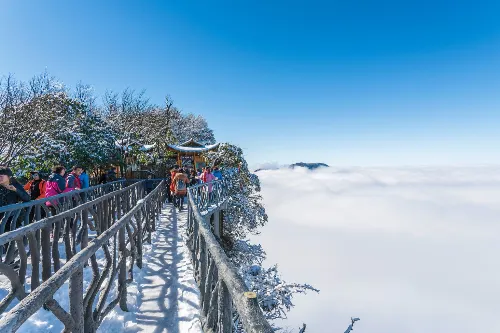
Guigu Plank Road
Guigu Plank Road is located in the Mixian Qijing Scenic Area and gets its name from hanging along the cliff on the upper side of Guigu Cave. The plank road is 1,600 meters long, with an average altitude of 1,400 meters. It starts at Yihong Pass and ends at Xiaotianmen. Different from other plank roads, the entire Guigu Plank Road is neither on the top of the cliff nor on the side of the cliff, but stands in the middle of a cliff thousands of feet high, giving people the feeling of rising and falling with the cliff.
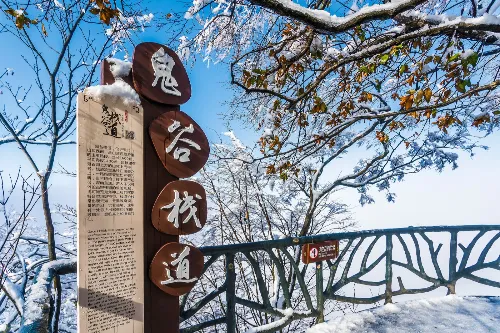
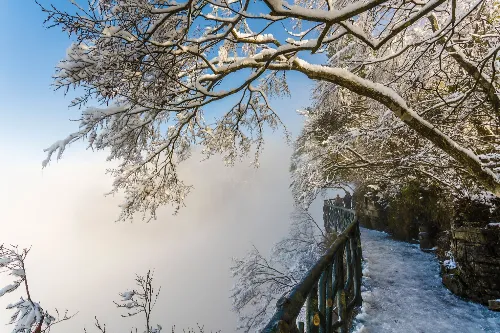
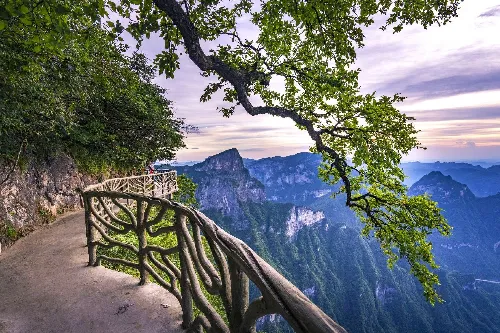
Tianmen Mountain Cableway
Tianmen Mountain Cableway, also known as "Rainbow Cableway Soaring like a Dragon", connects the urban area of Zhangjiajie with the top of Tianmen Mountain. It is 7,455 meters long, making it one of the longest alpine cableways in the world. The horizontal height difference of the cableway is 1,279 meters, and it is also the cableway with the largest local slope and the most supports in China. Tianmen Mountain Cableway has 98 cable cars and 57 cableway supports (including 3 rescue supports). It takes tourists about 28 minutes to take the cableway, which crosses the urban area, farmland, and canyons, providing a shocking experience.
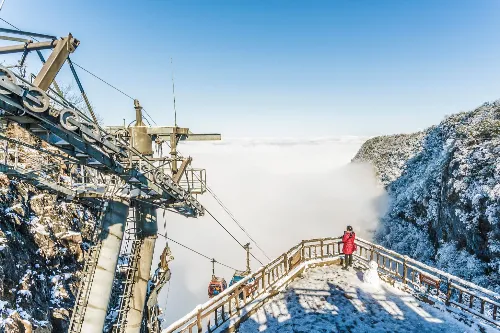
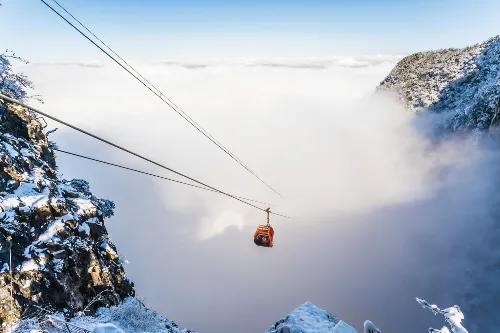
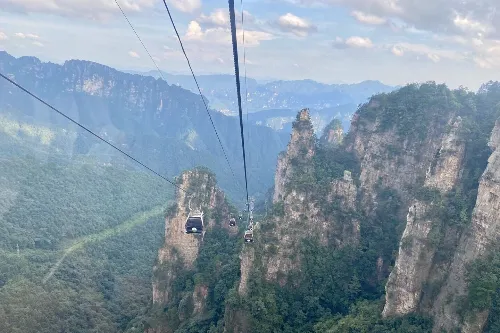
Tianmen Mountain Temple
Tianmen Mountain Temple is located in the southern part of the mountain top and is the core area of the "Buddhist culture" of Tianmen Mountain. The temple was first built in the Ming Dynasty and once had a prosperous incense, serving as the Buddhist center of western Hunan.
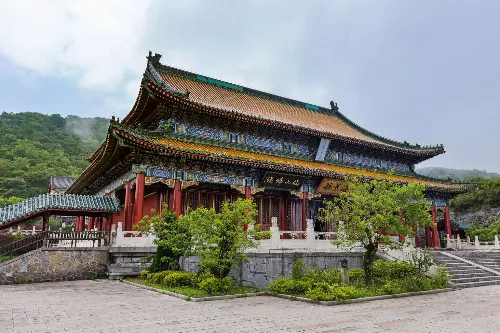
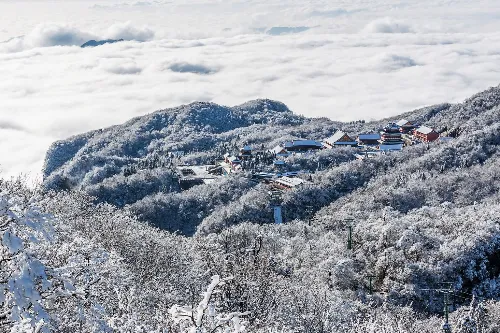
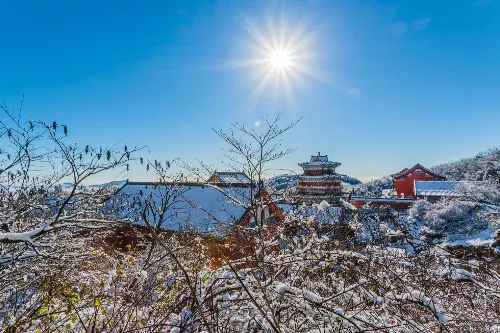
Biye Yaotai Scenic Area
Biye Yaotai Scenic Area has a complete primary secondary forest with a forest coverage rate of 90%. It preserves many rare plant species, such as Davidia involucrata and Liriodendron chinense, and is known as the "Sky Garden of Potted Plants". There are towering ancient trees, twisted vines, moss everywhere, and stone shoots and stone buds can be seen everywhere, making every corner look like a natural potted landscape.
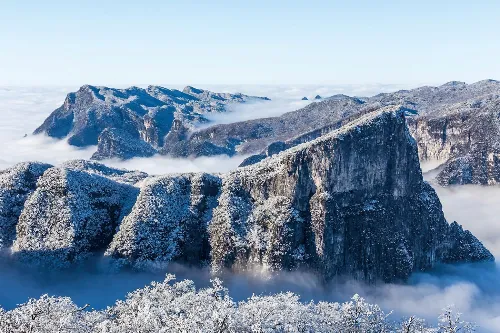
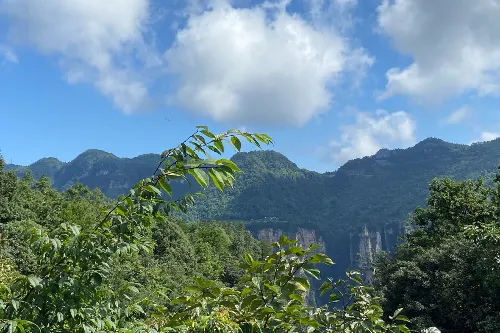

Tour Route
Tourists can first take the Tianmen Mountain Cableway up the mountain. After reaching the top, they can choose to take the West Line first to visit scenic spots such as the Glass Plank Road and Guigu Plank Road, experiencing the thrilling cliff views. The whole journey takes about 2-3 hours. Then head to the Middle Line to visit Tianmen Mountain Temple, staying for approximately 1 hour. Next, go to the East Line to enjoy the primary secondary forest landscape of Biye Yaotai Scenic Area, with a visiting time of about 1-2 hours. Finally, take the through-mountain escalator down to Tianmen Cave, climb the 999-step Heavenly Staircase, and then take an eco-friendly bus down the mountain along Tongtian Avenue. It is recommended to arrange 5-7 hours for the entire visiting process.
Travel Tips
- In spring (March-May), you can enjoy the rhododendrons all over the mountains. Meanwhile, the temperature is pleasant, suitable for outdoor activities. It is recommended to wear comfortable sports shoes and light clothing.
- In summer (June-August), Tianmen Mountain is a summer resort, with a temperature lower than that of the urban area. However, the ultraviolet rays are strong, so you need to bring sunscreen, sunglasses and other sun protection products.
- In autumn (September-November), you can admire the red leaves all over the mountains, and the scenery is very beautiful. At this time, the temperature difference between morning and evening is large, so it is better to bring a coat.
- In winter (December-February), if it snows, Tianmen Mountain is covered in silver, and you can enjoy the rime landscape. But you need to keep warm and wear thick down jackets, snow boots, etc. At the same time, since Tianmen Cave and Tongtian Avenue may be closed in winter, you should make travel plans in advance.
- Book tickets online in advance to avoid long queues during the peak tourist season.
- When walking on the Glass Plank Road and Guigu Plank Road, if you have acrophobia, you can slow down and walk while holding the handrail beside you.
Precautions
- Fireworks are strictly prohibited in the scenic area, and smoking is not allowed in non-smoking areas.
- When taking the Tianmen Mountain Cableway, follow the staff's arrangements and do not shake or fight randomly in the cable car cabin.
- When walking on the Glass Plank Road and Guigu Plank Road, move forward in order according to the signposts and do not crowd or push.
- Tianmen Mountain has a high altitude, and some tourists may experience mild altitude sickness. If you feel unwell, inform the scenic area staff in time.
- During the peak tourist season, there are many tourists at each scenic spot, so please keep your personal belongings safe.
- Do not feed wild animals randomly in the scenic area to maintain the ecological environment of the scenic area.
Transportation
- By plane: You can first arrive at Zhangjiajie Hehua International Airport, which is about 8 kilometers away from Tianmen Mountain National Forest Park. It takes about 20 minutes by taxi to reach the lower station of the scenic area's cableway.
- By train/high-speed rail: Zhangjiajie has Zhangjiajie Station and Zhangjiajie West Station. From Zhangjiajie Station to the lower station of Tianmen Mountain Cableway, it takes about 30 minutes by bus and 15 minutes by taxi; from Zhangjiajie West Station to the lower station of Tianmen Mountain Cableway, it takes about 1 hour by bus and 30 minutes by taxi.
- Urban transportation: In the urban area of Zhangjiajie, you can take buses No. 1, 4, 5, 6, 7, 10, etc. to the lower station of Tianmen Mountain Cableway Company. You can also choose to take a taxi to the scenic area.
Opening Hours
The scenic area is open from 07:30 to 19:00 (admission stops at 16:00). However, it should be noted that Tianmen Cave is not open all year round. In winter every year, due to road icing caused by snow, Tianmen Cave and Tongtian Avenue (the 99-turn mountain road leading to Tianmen Cave) will be closed.
Tickets
The ticket price is 278 yuan per person.
You can search for the official WeChat public account "张家界国家森林公园" to get the latest updates or buy tickets online.
Online Booking
Click here to jump to the Trip.com ticketing platform for ticket purchase.


